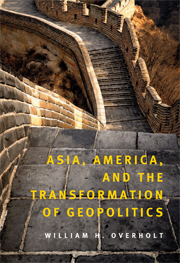Book contents
- Frontmatter
- Contents
- Figures
- Tables
- Preface
- Acknowledgments
- Overview
- CHAPTER ONE Introduction: The Inertia of Foreign Policies
- CHAPTER TWO Cold War Assumptions and Changing Realities
- CHAPTER THREE Regional Trends
- CHAPTER FOUR Asia's Big Powers: Japan and China
- CHAPTER FIVE Smaller Places, Decisive Pivots: Taiwan, Korea, Southeast Asia
- CHAPTER SIX The Aspiring Power and Its Near Abroad: India and South Asia
- CHAPTER SEVEN Russia and Its Near Abroad
- CHAPTER EIGHT The United States and the New Asia
- CHAPTER NINE Scenarios for the Future
- CHAPTER TEN Conclusion
- Bibliography
- Index
Preface
Published online by Cambridge University Press: 05 September 2012
- Frontmatter
- Contents
- Figures
- Tables
- Preface
- Acknowledgments
- Overview
- CHAPTER ONE Introduction: The Inertia of Foreign Policies
- CHAPTER TWO Cold War Assumptions and Changing Realities
- CHAPTER THREE Regional Trends
- CHAPTER FOUR Asia's Big Powers: Japan and China
- CHAPTER FIVE Smaller Places, Decisive Pivots: Taiwan, Korea, Southeast Asia
- CHAPTER SIX The Aspiring Power and Its Near Abroad: India and South Asia
- CHAPTER SEVEN Russia and Its Near Abroad
- CHAPTER EIGHT The United States and the New Asia
- CHAPTER NINE Scenarios for the Future
- CHAPTER TEN Conclusion
- Bibliography
- Index
Summary
This study examines how the structures and attitudes left over from the Cold War fit the current pattern of international relations in Asia and whether the post–Cold War adaptations of those structures and attitudes are serving the interests of the United States and the world. Then, to stimulate thought, it considers some alternatives that might evolve.
The structure of this volume reflects some crucial tradeoffs. Analysis of all the forces—political, economic, cultural, geopolitical, military—that affect Asia's strategic future could easily require the equivalent of a multivolume encyclopedia. The literature available for citation would fill a small library. Any attempt at such comprehensiveness would lose the main threads. Therefore I have chosen a relatively tight, provocative essay format. I have resisted the urge to elaborate many points at length and to put another three footnotes on every page.
Each section deliberately raises controversies that would require dissertations to resolve—and probably wouldn't be resolved even then. A key task for anyone trying to probe the range of future possibilities is to question reigning assumptions, to provoke and widen our imagination. If some proposition is already generally accepted, I have usually either ignored it or challenged it. There is something in the pages that follow that will upset virtually everyone—Chinese, Japanese, American, conservative, liberal, scholar, government official, private-sector executive. I hope to hear from anyone whose favorite preconceptions are not off ended by what I have written so that I can attempt to correct the omission. It is my hope that disagreements will be mainly about interpretations rather than facts.
- Type
- Chapter
- Information
- Asia, America, and the Transformation of Geopolitics , pp. xv - xxiiPublisher: Cambridge University PressPrint publication year: 2007

